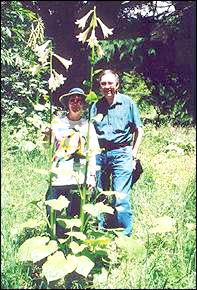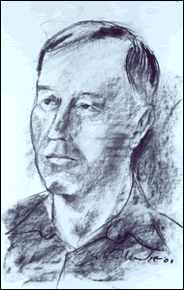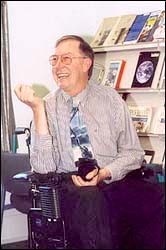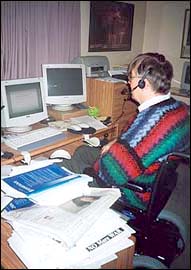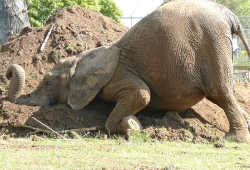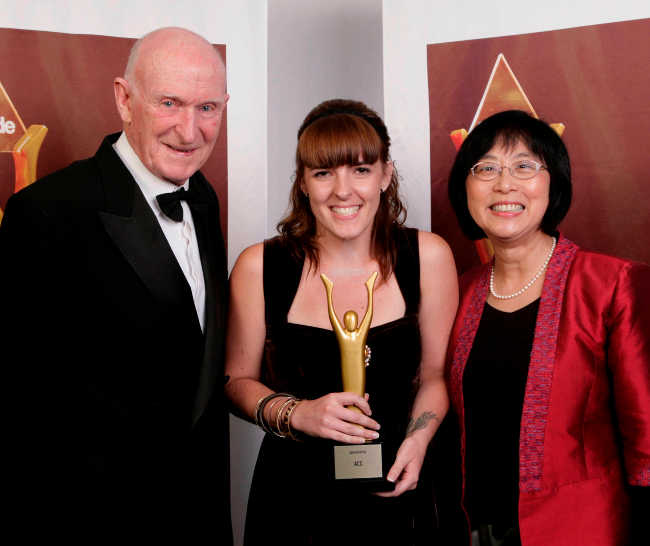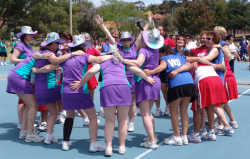A bitter-sweet time Dorothy – 17/09/03
In November 2001 Neil Cherry received sweet and bitter news – the award of the New Zealand Order of Merit for his work in science, education and the community, and a diagnosis of probable motor neurone disease.
November 27 2001 – the day when the wonderful news arrived Neil picked up the mail from the letterbox and set out to the Council offices where he planned to do some work. At the traffic lights near Hagley Park he noticed that one envelope had a Government address on it and wondered if it was from the tax department. When he reached the Council car park he opened it and saw it was from the Governor General and thought it was probably a Christmas greeting because it was the end of November.
When he finally read it he found that it was a letter offering him a royal honour for his work on science, education and the community. It was highly confidential.
Neil’s next thought was, “What do I do about this? What a wonderful thing to receive!” He immediately took off and went out to Burwood to see Gae at the Champion Centre, and told her he had received a letter that she might like to read. They celebrated together, and Neil returned to his work at the Council.
November 28 2001 – ominous news about Neil’s health The following day Neil and Gae went to an appointment with the neurologist about his health problems at that time, and received the diagnosis that his symptoms were probably due to motor neurone disease. He had a number of tests to eliminate other possibilities, but there is no clinical test to prove a diagnosis of motor neurone disease.
“The next little while was what I call a sweet and sour experience,” Neil said, “because I had that lovely letter from the Governor General to which I had replied accepting the honour with great appreciation, but also I had to deal with the fact that I had a probable terminal disease.
“I think that’s where both my science and my Christian philosophy came together with rejoicing on the one hand and problem solving on the other, reducing the negative aspect of the diagnosis and trying to turn that into the best we could do with whatever time I had left. That’s been the approach we have taken ever since.
“I had to go back to the neurologist and have nerve conduction tests where needles were stuck in my arms to see how the muscles in my arms would react to them. That was quite painful, but when they moved the needles around while they were in my arms it was very painful.
|
|
| Gae and Neil beside the tall Himalayan lilies |
“Next I had a second opinion and went through the whole process again apart from that test, and had lumbar puncture tests to try to get fluid out of my spine to make sure there was no cancer or other disease in my spine. There was no sign of other disease, so the diagnosis of motor neurone disease was confirmed by Dr Tim Anderson at the Christchurch hospital. He is now my neurologist and his care of me has been wonderful.”
Neil spent the Christmas and New Year period going through the diagnosing process which took several weeks.
Trip to Mount Peel to see the Himalayan lilies Neil and Gae had always intended to make the trip to see the Himalayan lilies on the day in December when the public are invited by the Acland family to visit Mount Peel Station and view the gardens. It was a beautiful day and they decided that after the diagnosis Neil had received it was time for action, not postponement.
While they were there Neil had his portrait drawn in charcoal by a local artist.
|
|
| Neil’s portrait |
New role at Lincoln University He let the authorities at Lincoln University know that he could not carry on lecturing because of his increasing disability, and as a result his position there changed. On January 1 2002 he became a Senior Lecturer of Environmental Health. This was a position without lecturing and his role was to undertake environmental health research and to promote Lincoln University and the University of Canterbury as the places to lead in producing solutions for a cleaner environment. These solutions, it was hoped, would also produce jobs in Canterbury and technology which could be sold to other areas. This was to be an integration of the good work done by both universities and also to give people in the universities a context and focus for their work in aiming for the common goal of a cleaner environment and a healthier community. There were to be cultural and strategic approaches involved in the appropriate application of the Resource Management Act.
He was to assess the effect of toxins in the environment, such as electromagnetic radiation and those toxins that came from the use of fossil fuels, to advocate safer technology for cell phones, and to promote the technical and engineering solutions. He was appointed to this promotional role because of his high profile in the community.
The Vice Chancellor, Dr Frank Wood, was very supportive of this role and actually extended the objectives from Neil’s original suggestion of just taking a safer technology approach. The extended scope included Neil’s work in environmental epidemiology, renewable energy and climate change. This new role enabled him to prepare for publication his first Schumann Resonance paper.
Neil described deep satisfaction with the Lincoln position and his ONZM “The position I was given at Lincoln was totally coherent with my position at the Council,” Neil declared with obvious satisfaction. “My research bringing all the understanding together to solve problems for the community was now my job. The diagnosis of my illness was to do that for me and my family, and my royal honour was in recognition of my multi-disciplinary research including the health effects of electromagnetic radiation, climate change and other related areas. Integrating all this to have a cleaner world was part of my royal honour.
|
|
| Neil in his new office |
Promotion to Associate Professor of Environmental Health “On July 1 2002, at the end of my contract as senior lecturer, I was promoted to Associate Professor of Environmental Health at Lincoln University. This was an emeritus position but with the status of an Associate Professor. This gave me total freedom for my research work and Council work and my increasing disability would not change my academic position because it was mine for life – for whatever life I had.
“The Lincoln staff and the Vice Chancellor and the Director of the Division of Environmental Management and Design, Dr Stephanie Rixecker, have all been extremely supportive. My original proposal was extended by the Vice Chancellor to make it more interesting for me, and the Director moved me to her area in the Human Sciences Department because human health is the primary part of my work. I was given the opportunity to continue my work as long as my health would allow.
“About twenty years ago I was teaching so much that I decided that getting my research results out to the community had to be my objective, so I shared my discoveries with journalists. People would ask questions, I would do the research necessary for an answer and I would get the answers out to the general public through the media and to my classes through my teaching. Getting so much information out through the media raised my profile so that when I was elected to the Canterbury Regional Council I received a very high level of support – 52.000 votes. Having become a politician I undertook my Council work as a very high profile scientist able to promote the Council, promote Lincoln and get the ideas and the understanding out to the public.”
Back to writing and research Neil’s work at Lincoln University and the Council meant that he did not get many research papers prepared for publication. However, in his new position as Associate Professor of Environmental Health he returned to writing. This was possible in spite of his disability because he used a voice-activated computer.
|
|
| Neil at the voice-activated computer |
Chapters for three books being published
Chapter on understanding climate to assist farmers One chapter on climate was written for a book to go out to farmers. The aim was for them to understand the weather and use their knowledge to increase production on their farms. It dealt with understanding drought, which is relevant in many districts of New Zealand at present.
This is a generally available book prepared by the Farm Management Department at Lincoln University and includes the kind of knowledge available through different departments of the university.
Chapter for book on Canterbury’s natural history The second was written for a book on Canterbury’s natural history and dealt with the aspects of weather which have been a subject of Neil’s research – climate, weather, climate change, the effects of nor’westers and of winter.
This was written for a book being produced at the University of Canterbury.
Chapter for a book being produced at Reading University, England. “Evidence to support the hypothesis that Electromagnetic Fields and Radiation are a Ubiquitous Universal Genotoxic Carcinogen.” For this book Neil was asked for permission to publish the review paper he had delivered at a congress in Italy in 2001. It was accepted for publication in 2002.
Papers accepted for publication Three papers on Schumann Resonance were accepted for publication by academic journals, the first in 2002 and the final two in 2003.
The first described how the Schumann Resonance signal is the biophysical mechanism for the human health effects which are related to solar and geomagnetic activity. Geomagnetic activity is the variation of the earth’s magnetic field caused by solar activity – solar flares, solar storms, solar cycles.
The second was on mortality effects in Thailand which all varied with the sunspot cycle, the mechanism being the Schumann Resonance.
The third paper was on the hypothesis that the Schumann Resonance signal has allowed human intelligence to develop.
Neil was making full use of the precious months that were left.
For more information about Neil Cherry’s scientific research go to his website www.neilcherry.com
Return to the index of Neil Cherry’s life story.

